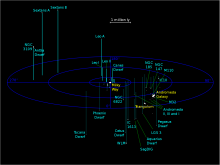Listen to today's episode of StarDate on the web the same day it airs in high-quality streaming audio without any extra ads or announcements. Choose a $8 one-month pass, or listen every day for a year for just $30.
You are here
Star Clouds
The Milky Way is splotchy. This hazy band of light has jagged borders, along with dark zones and bright zones. That gives the Milky Way an interesting texture.
The Milky Way outlines the disk of our home galaxy. It’s the combined glow of millions of individual stars. It’s so faint, though, that you need to get away from city lights to see it. Over the next few evenings, it’s visible across the eastern sky, from the teapot of Sagittarius in the south, through the celestial swan high in the east.
The Milky Way is divided by a dark rift across its length. It’s formed by dense clouds of dust. Dust grains absorb the light from the stars behind them, making it look like there are almost no stars at all.
But some stretches of the Milky Way show little dust at all. These zones form several bright “star clouds.”
There are two in Sagittarius. They show us regions toward the center of the galaxy. These regions contain huge numbers of stars and star clusters. In particular, they are windows on the next spiral arm inward from our own.
The biggest star cloud is in Cygnus. It flows along the swan’s body, from its heart to its beak. It is a window into the Cygnus arm, another wide lane of stars. So we’re looking into another zone that contains lots of stars.
A pair of binoculars will reveal many individual stars in these bright star clouds. And a telescope will reveal many more — some of the billions of stars that make up our galactic home.
Script by Damond Benningfield





